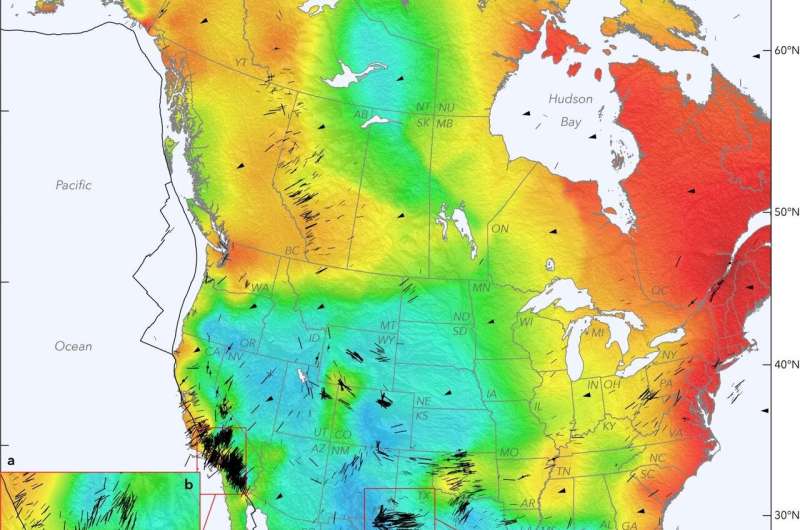This new-generation stress map of North America includes the first view of the style of faulting across the continent as well as more than 300 new measurements of the direction from which the greatest pressure occurs in the Earth's crust. The background color indicates relative stress magnitudes, or style of faulting. (Image credit: Jens-Erik Lund Snee and Mark Zoback) Credit: Jens-Erik Lund Snee and Mark Zoback
How do mountains form? What forces are needed to carve out a basin? Why does the Earth tremble and quake?
Earth scientists pursue these fundamental questions to gain a better understanding of our planet's deep past and present workings. Their discoveries also help us plan for the future by preparing us for earthquakes, determining where to drill for oil and gas, and more. Now, in a new, expanded map of the tectonic stresses acting on North America, Stanford researchers present the most comprehensive view yet of the forces at play beneath the Earth's surface.
The findings, published in Nature Communications on April 23, have implications for understanding and mitigating problems associated with induced seismicity—human-caused earthquakes—from unconventional oil and gas recovery, especially in Oklahoma, Texas and other areas targeted for energy exploration. But they also pose a whole new set of questions that the researchers hope will stimulate a wide range of modeling studies.
"Understanding the forces in the Earth's crust is fundamental science," said study co-author Mark Zoback, the Benjamin M. Page Professor of Geophysics in Stanford's School of Earth, Energy & Environmental Sciences (Stanford Earth). "In some cases, it has immediate application, in others, it may be applied decades later to practical questions that do not exist today."
First continental synthesis of data
The new research provides the first quantitative synthesis of faulting across the entire continent, as well as hundreds of measurements of compressive stress directions—the direction from which the greatest pressure occurs in the Earth's crust. The map was produced by compiling new and previously published measurements from boreholes as well as inferences about kinds or "styles" of faults based on earthquakes that have occurred in the past.
The three possible styles of faulting include extensional, or normal faulting, in which the crust extends horizontally; strike-slip faulting, in which the Earth slides past itself, like in the San Andreas fault; and reverse, or thrust, faulting in which the Earth moves over itself. Each one causes very different shaking from a hazard point of view.
"In our hazards maps right now, in most places, we don't have direct evidence of what kind of earthquake mechanisms could occur," said Jack Baker, a professor of civil and environmental engineering who was not involved with the study. "It's exciting that we have switched from this blind assumption of anything is possible to having some location-specific inferences about what types of earthquakes we might expect."
Zooming in
In addition to presenting a continent-level view of the processes governing the North American plate, the data—which incorporates nearly 2,000 stress orientations, 300 of which are new to this study—offer regional clues about the behavior of the subsurface.
"If you know an orientation of any fault and the state of stress nearby, you know how likely it is to fail and whether you should be concerned about it in both naturally-triggered and industry-triggered earthquake scenarios," said lead author Jens-Erik Lund Snee, Ph.D. '20, now a postdoctoral fellow with the United States Geological Survey (USGS) in Lakewood, Colorado. "We've detailed a few places where previously published geodynamic models agree very well with the new data, and others where the models don't agree well at all."
In the Eastern U.S., for example, the style of faulting revealed by the study is exactly the opposite of what would be expected as the surface slowly "rebounds" following the melting of the ice sheets that covered most of Canada and the northern U.S. some 20,000 years ago, according to Lund Snee. The discovery that the rebound stresses are much less than those already stored in the crust from plate tectonics will advance scientists' understanding of the earthquake potential in that area.
In the Western U.S., the researchers were surprised to see changes in stress types and orientations over short distances, with major rotations occurring over only tens of miles—a feature that current models of Earth dynamics do not reveal.
"It's just much clearer now how stress can systematically vary on the scale of a sedimentary basin in some areas," Zoback said. "We see things we've never seen before that require geologic explanation. This will teach us new things about how the Earth works."
More information: Nature Communications (2020). DOI: 10.1038/s41467-020-15841-5
Journal information: Nature Communications
Provided by Stanford University
























